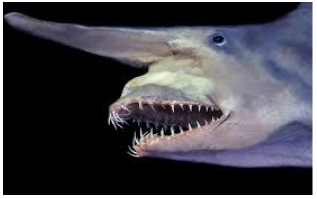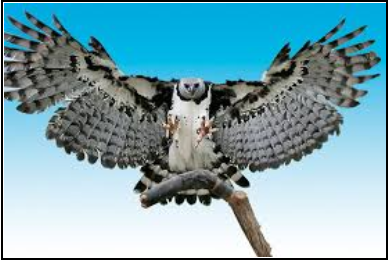Animals That Will Make You Jump!

October 17, 2019
Are you scared of different animals like snakes, sharks, or birds? Here are three animals, the Goblin Shark (a physically-unique fish), the Inland Taipan (the most poisonous snake), and the Harpy Eagle (the bird with the largest talons in the world) that can get you into the scary Halloween Spirit!
The Goblin Shark
The Goblin Shark is one of the more odd-looking fish. It has a jutted-out long snout called the rostrum, which is covered with unique sensing organs that gives it the ability to use a sense system known as ampullae of Lorenzini that help it to use electro detection to find its prey. The Goblin Shark lives 1,300 meters below the surface of the water — that’s 4,265 feet! Scientists believe that they only come up near the surface at night, living most of their lives in the dark. Its flabby skin can range from pinkish purplish grey with light blue on its fins to bubble gum pink! It’s strange jaws are the key for ambushing its prey such as large and small fish, other sharks and rays, and they also eat squid and crustaceans like crabs. If you thought New Yorkers walked fast, this shark’s bite can deploy at a speed of 10.1 feet per second!
If you see this rare fish you will notice its 26 jagged awl-like teeth on their upper jaw and 24 on their lower jaw with three rows of anterior replacement teeth on each side of both jaws! The shark can grow up to 10 to 13 feet long (but has never passed 18 feet as observed by scientists) and weigh up to 460 pounds!
The Goblin Shark has a very old animal lineage, dating back some 125 million years. And the oldest individual shark was 36 years! Even though this large shark looks like a dangerous being, if a human comes near it (though it rarely happens) there is only a small chance the shark might hurt the human because of its size.
The Inland Taipan
This is the most poisonous snake in the world, and it can kill you in 45 minutes after being bitten by its 3.5 – 6.2 millimeter fangs. The snake’s venom is 50 times more toxic than a King Cobra’s and will cause muscle weakness and paralysis. Although this creature is shy and rarely bites humans, those who are bitten will usually die. Ricky Harvey, a Ballarat man, was bitten by his pet an Inland Taipan on the thumb and barley survived. He is one of the few lucky people who successfully fought off the poison that ca n supposedly kill 100 men with one drop.
n supposedly kill 100 men with one drop.
The Inland Taipan, also called ‘The Fierce Snake’, is an amazing and beautifully colored snake. Its back can vary from from black, to light brown, even light green! Its head is usually darker than its body. Its scales change seasonally, usually lighter during the summer and darker during the winter. Its eyes can be reddish or very dark brown and its belly is more yellow-ish and gets darker as you make your way toward the tail. The Taipan is commonly two meters long, about six feet, and the largest recorded was about ten feet long!
The Inland Taipan eats only small mammals and birds, killing them by biting very hard repeatedly before releasing them to die. This snake can bite eight times in a single attack. Then they slither back to their den, usually a crack in the dirt or an abandoned animal den. The animals who lived there the snake might have eaten. Its favorite food is a Plague Rat, also known as the Rattus villosissimus. But It also has a foe. The Mugla Snake also known as the King brown snake is a lot larger and kills the Tapian with its venom. The Mugla is another poisonous snake of Australia.
This snake lives in different regions of Australia such as the far west and southwest of Queensland, extending through the far west of New South Wales into the northeast corner of South Australia, and into the southeast of the Northern Territory.
The Harpy Eagle
The Harpy Eagle has the largest talons of any bird in the world, as long as grizzly bear claws! The five inch talons are great for grabbing prey like fish, tree-dwelling mammals like sloths, opossums, and monkeys. The big birds also eat birds, such as macaws and reptiles like iguanas. As apex predators, they will pretty much eat any animal they can catch and carry up a tree. The females are larger so they have larger targets, leaving smaller carcasses for their mates.
It is hard to tell a female and male apart since male and female plumage is identical. They both have dark gray feathers with a white underside, with a black band of plumage spans its neck, and a fan of gray feathers crowns its head. A female Harpy is double the size of the male eagles and can get between 36-40 inches and weigh up to 13-20 pounds! A male eagle can only weigh 9-11 pounds! Its wingspan is small, only 6.5 feet long, to swoop through the rainforests canopies it calls home with great agility.
This eagle lives in many places throughout Central and South America. They are mostly found in countries like Brazil, Ecuador, Guyana, Suriname, French Guiana, Colombia, Venezuela, Bolivia, Paraguay, Peru, and northeast Argentina. They can also be found in Central America or Mexico but their populations are relatively small there.
When eagles mate at four or five years old, they stay together for life. Their large nests are made with sticks and branches and are lined with soft materials so the nests are comfortable. The nests are built in larger trees like the Brazil nut tree, Kapok tree, and the Cambara tree. Like Bald Eagles they often reuse their nests for many years. The females lay two eggs but when one of them hatches, they completely ignore the remaining egg and it will not hatch. Both the parents spend all their time caring and protecting their chick until it fledges usually in 6 or 7 months. The fledgling returns to the nest over the next 6-10 months for an occasional free meal. The pair of Harpys breed and produce a new chick every 2-4

years.
The Harpy Eagle is at-risk for being endangered because of increased habitat loss from development, logging, and agriculture. It’s currently listed as Near Threatened by the IUCN.
These animals might be terrifying, but you will probably never encounter them in real life. Learning about these three scary animals should get you into the Halloween spirit. Happy Halloween!
Works Cited
“Fierce Snake Habitat, Diet & Reproduction – Reptile Park.” Australian Reptile Park – Wildlife Park Sydney & Animal Encounters Australia, 22 May 2017, reptilepark.com.au/animals/reptiles/snakes/venomous/fierce-snake/.
“Jungle Eagle.” PBS, Public Broadcasting Service, 28 May 2015, www.pbs.org/wnet/nature/jungle-eagle-harpy-eagle-fact-sheet/7263/.
“Mitsukurina Owstoni.” Florida Museum, 5 Apr. 2018, www.floridamuseum.ufl.edu/discover-fish/species-profiles/mitsukurina-owstoni/.




